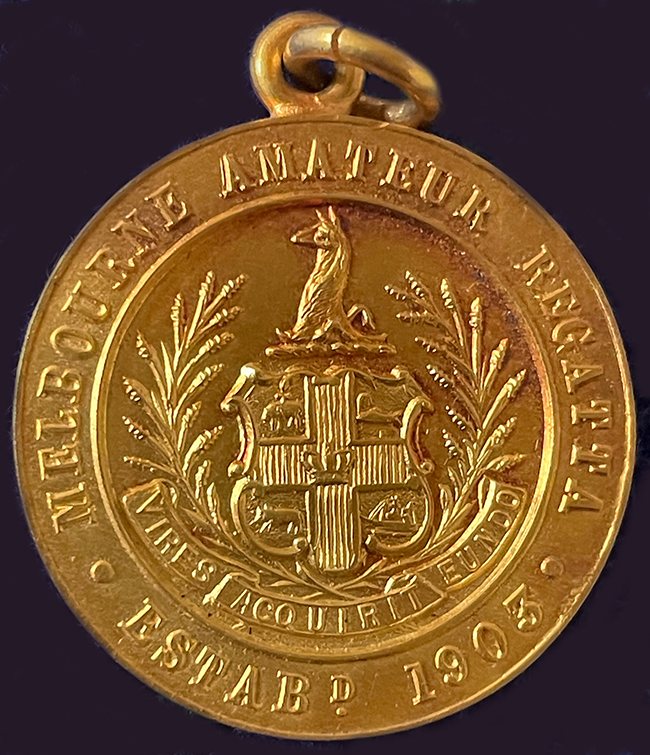Pre-WWI, Rapid Start
Pre-WWI, Rapid Start
Racing results, including names of the winning crews, can be found in the challenge trophy chapter beneath the description of the various challenge cups.
Association annual reports can be found in Appendix B and regatta programs in Appendix C.
From the first regatta in March 1904, the regatta was a huge success and quickly became the premier sporting event in Melbourne. It captured the imagination and patronage of the citizens of Melbourne, being a carnival rather than a regatta. Following the first few years, it regularly attracted crowds of over 100,000, conducting a consistent quality and much sought after social event. It took WWI to temporarily bring the growth and prominence of the regatta to an end. The revival of the regatta in 1919 proved to be a greater event than before the war.
It is important to realise that this was a carnival which used rowing as a base. It was a social event that Melbourne clearly needed and the rowing was a pleasant distraction. The evening activities which included lighting displays and fireworks, rapidly became as or more important than the daytime activities. The regatta Committee understood this and catered for the crowds superbly whilst keeping to the principles outlined by the founders.
March 1904
Although it was always the intention of conducting this regatta in the spring, the first regatta was held on 19th March 1904 and was a great success. Despite a cold and dull morning, sunshine broke through to lift spirits for the afternoon of racing. There was a large spectator presence as the images below will testify.
From the very first regatta, it was intended to be a social event as much as a rowing event. The Argus reported that the evening entertainment attracted a similarly large crowd to the regatta during the day.1
The first race started at half past 1 o'clock and from beginning to end the racing, was good. The principal event of the day the Grand Challenge Cup was won by Ballarat who after beating Albert Park in the first heat won the final from Mercantile by a length. The maiden eights was an event which was keenly contested and was eventually won by Hawthorn. Albert-park was successful in the junior fours and the maiden fours, while Essendon secured the Stewards Challenge Cup. H Bourke (Tamar) won the Yarra Challenge Sculls. At the conclusion of the racing His Excellency the Governor General presented the prizes to the winning crews.
Perhaps as large a gathering as that present in the afternoon assembled at night to witness the illuminations and the display of fireworks, which ended the day's entertainment. Fairy lights of various lines took the place of flags and outlined the house boats and boathouses, casting their dancing reflections upon the water. At intervals coloured fire - green or red or blue- illuminated the river from side to side, or fiercely hissing rockets shot and discharged their brilliantly tinted balls of light into the air. Altogether it was a pretty scene, and a fitting termination to one of the best day's racing ever seen on the Yarra. Praise is due to Captain Rivett who suggested the holding of the regatta and finding a hearty response threw himself into the work of management with great heartiness.
In another article on the regatta, The Argus dwelt on the social aspects of the regatta, those present and the houseboats, which were also used in evening with guests in evening dress. The article concluded: In the evening the Chinese lanterns, the gaily-lighted houseboats, with their guests in evening dress, the fireworks, the passing boats of all kinds full of pleasure seekers, made such a scene as the Yarra has never known before, but is evidently destined now to know annually.
In many years to come, the Moomba festival in Melbourne would be created off Australian Henley carnival, and then surpass it in popularity.
The following Challenge Cups were competed for: Grand Challenge Cup for eights, Stewards Challenge Cup for fours and the Yarra Challenge Cup for sculls. The Stewards Challenge Cup race was a disappointment with Yarra Yarra RC leading into the last bend but were disqualified for a foul on that bend.
The course for the first regatta finished in front of the boatsheds providing good spectator vantage points on both sides of the river and on Princes Bridge. The same course was used from 1904 to 1907 and was about 100 yards more than a mile.
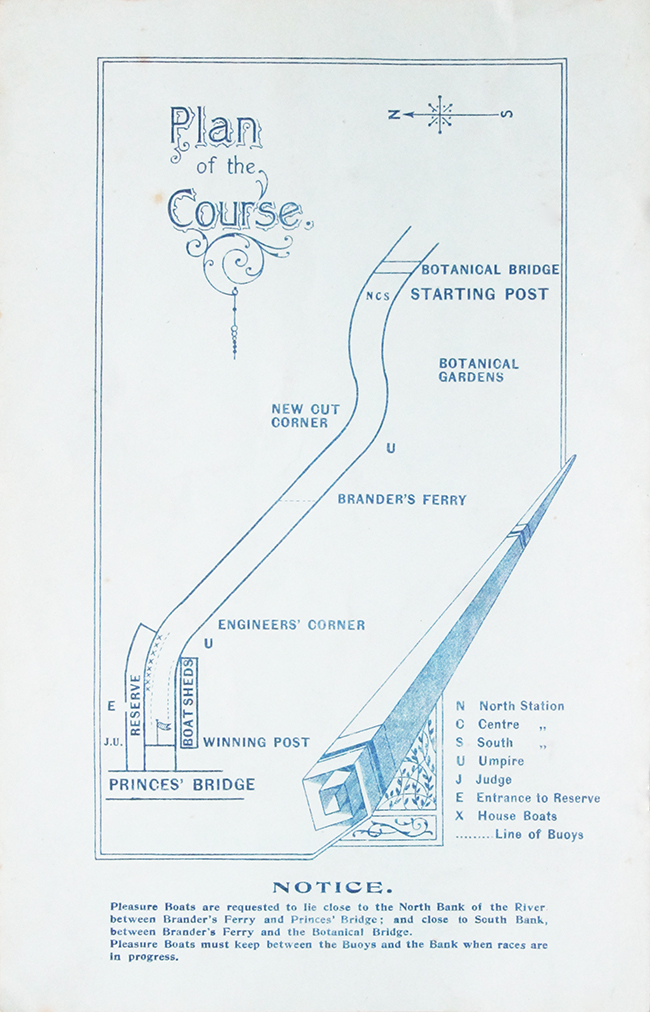
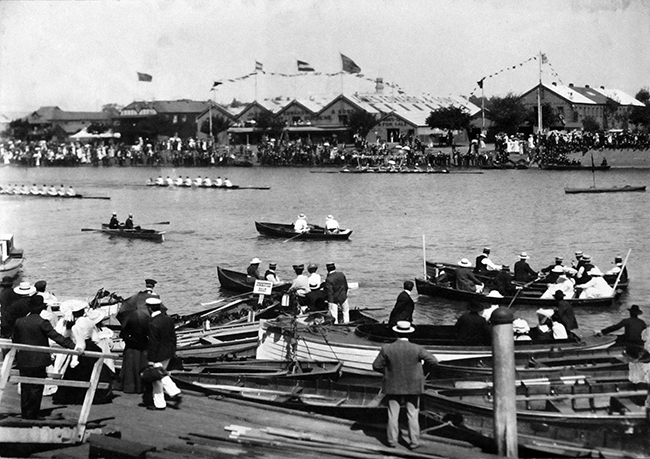
The finishing line
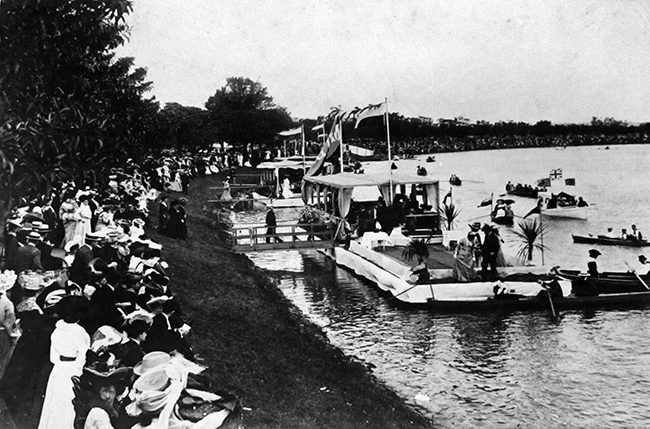
The first house boats at the March regatta which were moored on the north bank - the one in the foreground is from MUBC
At a meeting of the Committee and Subscribers conducted in June 1904, it was reported that Subscribers had provided £438 14 6 and a credit balance remained in the bank of £314. This was after expenditure of £223 3/6 on Challenge Cups and trophies.2 It was highlighted that the most satisfactory balance in hand was sufficient to meet all, liabilities entailed by the non-success a future regatta owing to bad weather or other causes. The comparison to impecunious rowing clubs was highlighted.
| Event | Won by | Other starters |
| Grand Challenge (senior eights) | Ballarat RC | Albert Park, Banks, Mercantile |
| Stewards Challenge (senior fours) | Essendon RC | Ballarat RC, North Esk (Launceston), Essendon, Footscray City, Albert Park, Yarra Yarra |
| Yarra Challenge (sculls) | Mr H Bourke (Tamar, Launceston) | Mr Horace Stevens (Mercantile), Mr George Brown (Civil Service), Mr Harold Brasch (Mercantile), Mr C Stamper (Albert Park) |
| Junior fours | Albert Park RC | Yarra Yarra |
| Maiden eights | Hawthorn RC | Footscray City, Ballarat City, Wendouree, Mercantile, Essendon, Civil Service, Albert Park, Banks, Yarra Yarra, MUBC, Bairnsdale |
| Maiden fours | Albert Park | Mercantile Banks, Seymour, Shepparton |
Gold medals were presented to winning crews of the Challenge Cup races.
At the May 25 1904 meeting of the Association, special mention was made of the work of Capt Rivett in organising the regatta. At the August meeting, Capt. Rivett advised of his moving to Sydney on business. John Lang joined Capt Rivett as joint secretaries of the Association. The meeting also agreed that a new challenge cup be presented for school crews to be known as the Ladies Challenge Cup.
October 1904
The second regatta was conducted on 22nd October 1904. It attracted even more attention and spectators than the first regatta despite the bad weather being described as dull, cold, windy with occasional showers.3 The water was also quite lumpy, specifically in front of the boatsheds, making it difficult for crews. The annual report went further stating that the weather conditions were almost the worst experienced on the Yarra. Spectator numbers were less than would have otherwise attended. The large number of those that did attend enjoyed a carnival like regatta with good racing.
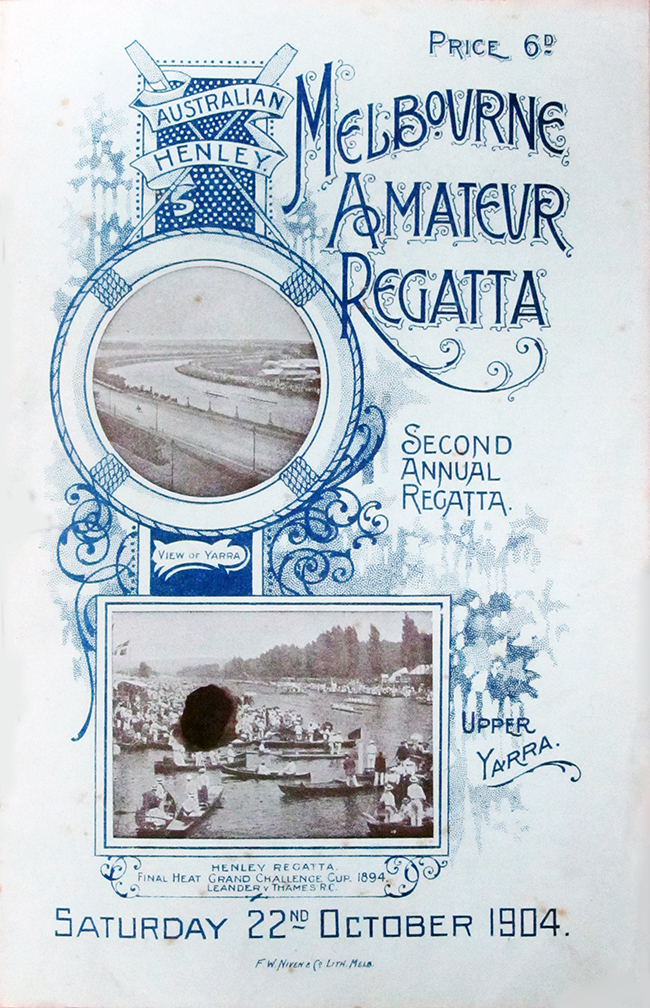
The Ladies' Challenge Cup for school eights was the new event on the program and created quite a lot of interest. More interest in fact than the Grand Challenge Cup which had only two competitors and was won again by Ballarat. Melbourne Grammar defeated Wesley College by two feet and became the first holders of the Ladies Challenge Cup. "All the boys rowed with pluck and determination". Interestingly, the maiden eight race scored the fastest time of the day. The Stewards Challenge Cup for senior fours was again a disappointment with Mercantile disqualified on the last bend for a foul for coming in too close despite being well in front.
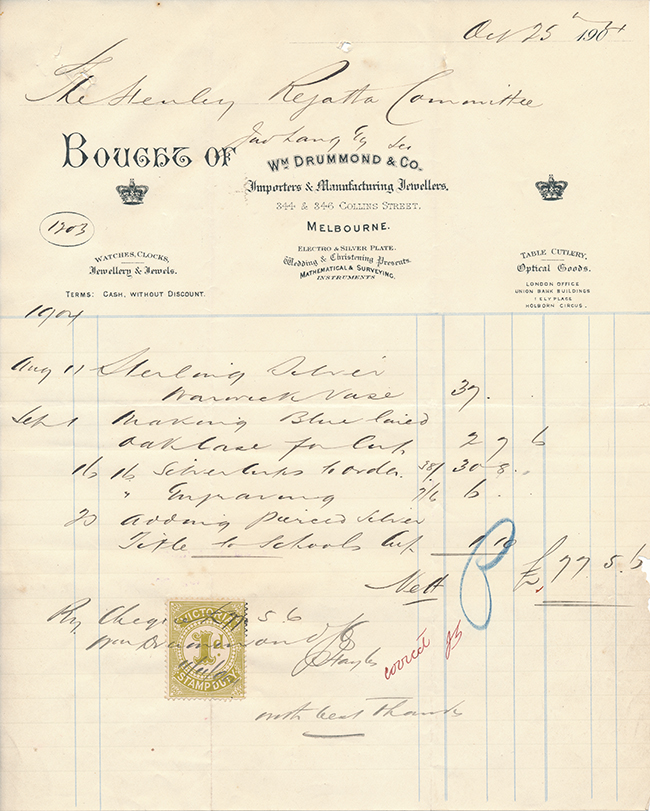
Invoice for the Ladies Challenge Cup bought by the Association
Of note was the use of subscribers as boat race officials, following the tradition of Henley Royal Regatta stewards.
The number of house boats continued to rise with the city clubs beginning to appear with a boat reserved for the Melbourne Club members and guests. House boats were occupied by the the Governor General, the State Governor, the President of the Association, the University boat club, the Officers of HMS Cerberus, the Officers of the Royal Australian Artillery, the City of Melbourne, the Melbourne Club and Mrs L K S MacKinnon and Miss Simpson.
Again an evening of lighting and fireworks finished off the day which attracted good evening crowds.
Given the poor weather, the regatta was run at a a loss of £60, thus reducing the capital of the Association to £204. The annual meeting in June 1905 noted with regret the deaths of Founder Arthur Blackwood and Executive Committee man Harry Brush.
| Event | Won by | Other starters |
| Grand Challenge (senior eights) | Ballarat RC | Albert Park |
| Stewards Challenge (senior fours) | Nagambie RC | Mercantile, Banks, Ballarat |
| Yarra Challenge (sculls) | Mr Harold Brasch (Mercantile) | Mr George Brown (Civil Service) |
| Ladies Challenge (school eights) | Melbourne Grammar | Wesley College, Geelong College, Scotch College |
| Junior fours | Hawthorn RC | Albert Park, Yarra Yarra |
| Maiden eights | Nagambie RC | Yarra Yarra, South Melbourne, Wesley College, Albert Park, Mercantile, Essendon, Banks |
| Maiden fours | Footscray City RC | Albert Park, Civil Service, Hawthorn, Mercantile |
Of interest was the presentation of Henley pots, which were possibly presented for the first time at this regatta. Gold medals were also presented to winners of the challenge cups.
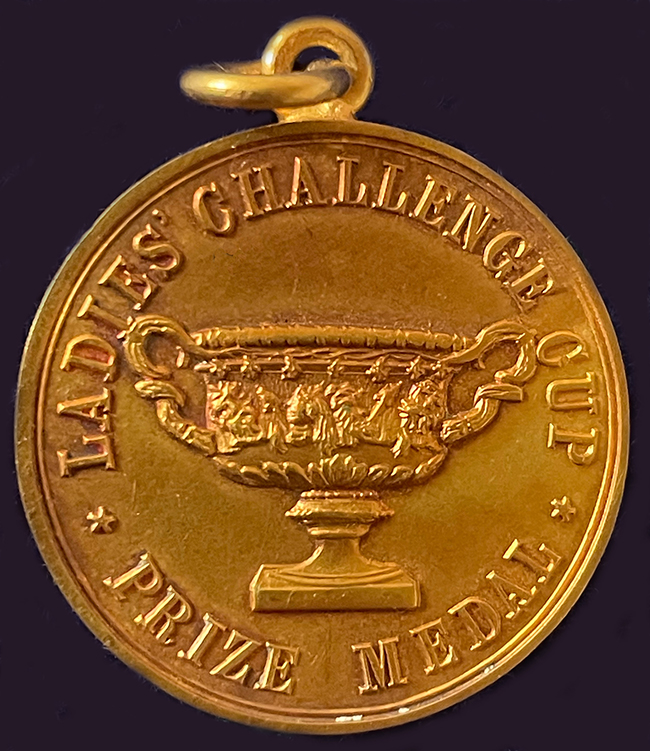
Gold medals presented for the inaugural Ladies Challenge Cup winners - from the Edward Cordner collection
1905
The weather was excellent for the regatta and some 40,000 spectators attended the regatta on 28th October 1905.4 The Argus reported as follows:
Melbourne did its Yarra justice on Saturday. Not the most sanguine member of the Melbourne Amateur Regatta committee ever anticipated that Henley-on-the-Yarra would have been the wonderful success it was. The effect of such success has been to create a water carnival to rank in aquatics as a fixture like the Melbourne Cup in racing, the final test match of an English cricketing tour, or the Austral Wheel Race in cycling.
With such a regatta as Henley has proved to give it the necessary fillip of public interest, the small band of enthusiasts whose untiring energies have kept rowing up to a high athletic standard for many years may rest content that a fine healthy sport, in which no suspicion of mal-practices ever enters, will become increasingly popular. Henley Regatta was an example of efficient organisation. There was not a hitch nor an error throughout, and the machinery by which such results were attained was invisible. One of the striking features of the regatta was the utter absence of restriction. All the spectators had the greatest freedom to go where they pleased and act as they pleased, but so excellent were the arrangements that that everything worked with the precision of a perfectly disciplined army. Great credit is due to the committee, of which Mr. George Fairbairn, M.L.A., is the president, and Mr. John Lang the secretary. The only matter to be regretted in the whole affair was the absence of Captain Rivett (now in Sydney), who projected and organised the first regatta two years ago, in the face of enormous difficulties.
It is important to dwell on the loss of the driving force behind the carnival, Capt. Rivett, who had to move to Sydney to take up the position of General Manager of the Co-operative Wool and Produce Company. Such a driven and detailed man was an enormous loss to Henley. However he could not have chosen a better person in John Lang to take over. Perhaps not the person to initiate such a carnival, Lang was the perfect person to run it. He had a superb eye for detail and protocol, ample energy and possessed a deep love of the sport. For a demonstration of his skills one need look no further than his authorship of probably the greatest rowing history compiled in Australia, the Victorian Rowing Oarsman and Rowing Register which was published in 1919. It is a complete history of the sport in Victoria to that date including all regatta results. It is the model on which this website is fashioned.
The event was a social event of grand proportions with now many houseboats moored and of course the fireworks display at night, bands, food sellers, bunting everywhere and spectators from the Botanic Bridge to Princes Bridge. The houseboats were allotted for the Governor-General, The President George Fairbairn, Lachlan Mackinnon of the Melbourne City Council, the Cerberus officers, Australian Club, Melbourne Club, Alexandra Club, Savage Club, MUBC, Miss Simon, and Mrs Mackinnon and finally Mrs William Bates.5 The festivities all finished at about 9pm with the playing of the national anthem.
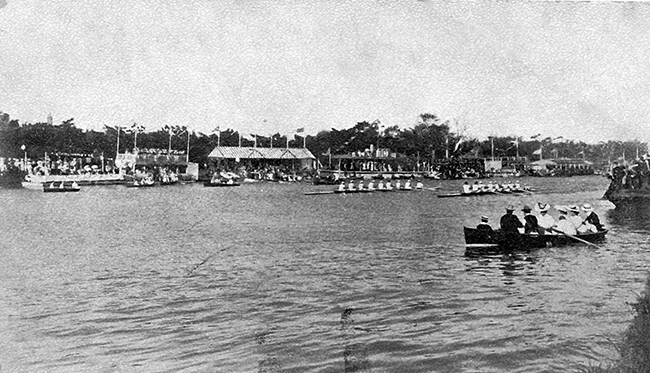
The regatta in 1905 showing how much the house boats had developed in size
The racing was also interesting. The wins went to Mercantile (2 wins) and one each to South Melbourne, Wesley College, Wendouree, Hawthorn and Albert Park. Again with two entries only in the Grand, Albert Park broke the two regatta winning streak of Ballarat in a close race won by only 2 feet.
Percy Ivens won the Yarra Challenge Cup with his Club Mercantile also taking out the well entered maiden eights race from Banks. Also well contested was the maiden fours which was won by South Melbourne.
The Association had obviously reached the stage that it was possible to think beyond the running of the regatta with £50 being donated to send the Victorian crew to the Interstate Championships. Even after this substantial gift, the credit balance of the regatta committee stood at £549. This was to be the start of much assistance given to both rowing in Victoria, but also to the betterment of Melbourne with landscaping and other river improvements.
| Event | Won by | Other starters |
| Grand Challenge (senior eights) | Albert Park RC | Ballarat RC |
| Stewards Challenge (senior fours) | Hawthorn RC | Albert Park, Ballarat, Nagambie, Mercantile |
| Yarra Challenge (sculls) | Mr Percy C Ivens (Mercantile) | Mr R Adams (Mercantile), Mr C Stamper (Civil Service) |
| Ladies Challenge (school fours) | Wesley College | Geelong College, geelong Grammar, Melbourne Grammar |
| Elswick Challenge (junior fours) | Wendouree RC | Seymour, Yarra Yarra |
| Maiden eights | Mercantile RC | Albert Park, Banks, Civil Service, Essendon, Footscray City, Hawthorn, Nagambie, South Melbourne, MUBC, Yarra Yarra |
| Maiden fours | South Melbourne | Albert Park, Barwon, Banks, Civil Service, Essendon, Footscray, Mercantile, Nagambie, Richmond, Sandhurst, MUBC, Yarra Yarra |
1906
The effects of having a major carnival were beginning to show with preparations of the river taking much work over a longer period of time. It was now more difficult to find rowing results amongst the many columns of discussion of the event and pictures. It was now more of a carnival than Henley Royal Regatta.
The popularity of the event caused behaviour issues with Club Captains asked to get their members to help control crowd behaviour.6 Also the inevitable occurred with a youth tragically drowning on the evening of the regatta in the Yarra River. He was in a canoe which capsized and he could not swim.
This was a very sad end to an excellent evening of fireworks, gaily lit boat houses and Princes Bridge, and of course the parade of illuminated house boats.
The day time social events were again a hit with spectator numbers increasing yet again. The carnival atmosphere and superbly dressed spectators made it a Melbourne hit.
Rowing innovations continued to abound including the umpire, George Upward, following the races in a launch. Also the river was closed to other motor boat traffic given past interference with racing. Again judging was undertaken from the Committee boat. The absence of a schools race disappointed spectators and led to one disappointed reader of The Argus to note it in a letter to the Editor.7
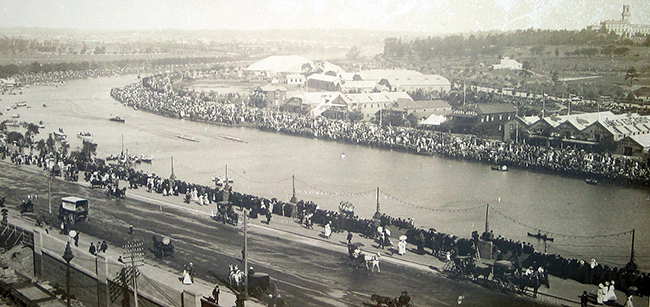
Semi-final of the Maiden Eights with eventual winners Civil Service leading. They won by 2 feet. Note the following umpires launch.
The lack of entries in the Ladies Challenge Cup was a disappointment for the Association and was noted in the annual report as follows: There were no entries for the Ladies' Challenge Cup, which your Executive decided should be for School Fours at this last regatta, instead of for Eights, for which it had been founded. This alteration was made in consequence of the Public Schools deciding that the training for the annual Public Schools Race interfered with their training for the Ladies' Challenge. It was unfortunate the Public Schools gave us very short notice of their intention not to compete in the Ladies' Challenge Eights, as the short notice of alteration of published programme from Eights to Fours was a matter of some consequence to other likely competitors.
The Association adopted a design for the Association colours (light blue, dark blue and red) and ordered a supply of hat banks etc. In October 1907, the Association registered the design.
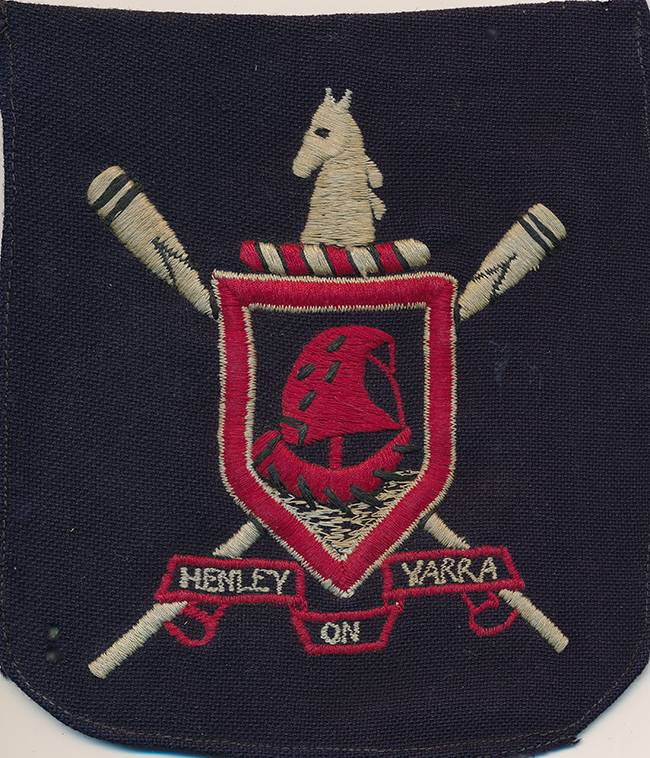
Thought to be the original design in the form of a blazer pocket
The annual meeting in June 1907 showed how successful the regatta was with the Association now boasting a capital of £857. The Executive Committee was authorised to continue to financially support the Victorian crew competing in the Interstate Championships. The Committee also seriously considered supporting an Australian crew to race at 1908 Olympic Games and sending a combined universities crew to race Oxford and Cambridge University crews. The aim being to have Australian rowing recognised internationally. At that time, the university option received good support which indicates the relative status of the Olympic Games at that time. The Committee were asked to continue investigations.8 Whilst this work did not result in Australian representation at 1908 Olympic Games, it was not wasted. The Association was primed to assist Australian representation and became the largest funder of the 1912 Olympic eight and sculler.
| Event | Won by | Other starters |
| Grand Challenge (senior eights) | Albert Park RC | Mercantile |
| Stewards Challenge (senior fours) | Mercantile RC | Albert Park, Hawthorn |
| Yarra Challenge (sculls) | Mr Harold Brasch (Mercantile) | Mr G Brown (Richmond), Mr C Stamper (Civil Service), Mr A Scott (Ballarat), Mr J C Fitzgerald (Civil Service) |
| Ladies Challenge (school fours) | No entries | |
| Elswick Challenge (junior fours) | Footscray City RC | Albert Park, Mercantile, Nagambie |
| Junior eights | Albert Park RC | Ballarat, Mercantile, Yarra Yarra |
| Maiden eights | Civil Service RC | Albert Park, Banks, Barwon, Civil Service, Essendon, Footscray City, Mercantile, South Melbourne, MUBC, Collegians, Yarra Yarra |
| Maiden fours | Corio Bay RC | Albert Park, Banks, Civil Service, Footscray City, Hawthorn, Mercantile, Nagambie, Richmond, South Melbourne, MUBC, Yarra Yarra |
1907
The regatta was again a huge success. At the annual meeting of subscribers held in June 1908, it was noted that the reserves of the Association rose as a result of the good regatta to £1,084. This was after £150 was given to the Public Works Department to create lawns on the south bank which will become the reserve for the regatta rather than the existing northern bank reserve. This change was as a result of a change to the course proposed for 1908 regatta with the finish line on the corner rather than in front of the boatsheds.
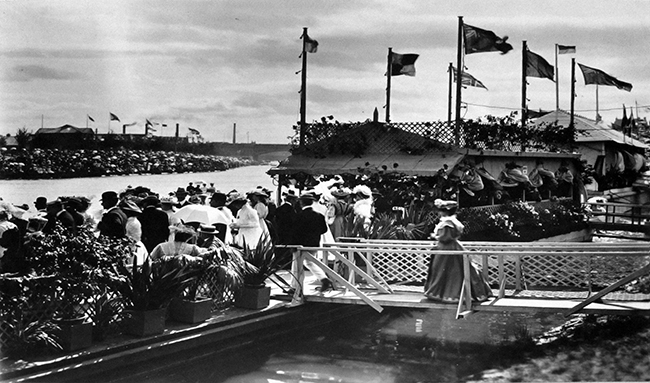
The Alexandra Club house boat - this was the last year of the reserve and the major houseboats on the north bank
Crowds of over 40,000 people, including most dignatories in Melbourne, again thronged to be part of this very social carnival. The Argus wrote a long article on the social aspects of the regatta and a much smaller article on the rowing, reflecting the nature of the event.9 It correctly summed up that: The regatta was essentially a spectacular show.
It gushed about the importance of the event as follows:
FIFTH ANNUAL REGATTA.
ENORMOUS ATTENDANCE.
A GRAND SPECTACLE.
The fifth Henley on the Yana Regatta has come and gone, and has left in its wake a train of pleasant memories. Five years ago no one would have predicted that an aquatic carnival held on the banks of the Yarra would have attracted an attendance of over 40,000 people, yet this has fallen to the lot of the Henley committee, and, though mortals do not as a rule command success, the promotors have both commanded and deserved it. They are to be congratulated on having added an important item to the list of Melbourne s holiday fixtures. More than that, the committee has succeeded in demonstrating the great possibilities of the Yarra for a spectacular fete. It has given a wonderful stimulus to rowing which hitherto has been a sport availed of by very few.
Clearly there had been mutterings that the Melbourne City Council should share in the financial rewards of the carnival as the article goes onto to emphatically call for them to keep their hands off the event. The argument concluded with: Instead, the City Corporation should realise what it will do towards making Melbourne the capital of Australia in the full sense of the term, and assist the promoters heartily to make it more successful every year. As an aside, it is recorded in the Committee minutes that the Council wanted 50% of the profits of the regatta. The matter was considered such a serious matter that a special general meeting was called on 17th September 1907 at which it was resolved to pay the City Council £50 for the right to fence the Reserve and if not accepted by the Council, to move the regatta to Albert Park Lake. Further it was agreed that the correspondence with the Council should be published if a satisfactory result was not achieved. The minutes of the meeting showed that the Council was not without supporters on the Committee who stressed that a strong partner like the Council was important for the regatta.
The correspondent added in response to those who criticised the Yarra River for pollution and industry on its banks: The Yarra looked dignified and almost majestic on this occasion. All things considered Melbourne has every reason to be proud of its river.
The racing was again good with the maiden races well contested by good entries. Sadly Harold Brasch had a row over in the Yarra Challenge, as did Scotch College in the Ladies Challenge. Nagambie excelled in the Stewards and Mercantile took out the Grand. The Committee noted their disappointment in the lack of entries given the expectations raised beforehand.
The City Council took control over motor-boat traffic which was gratefully received by the Committee. It was not fully effective all afternoon.
The general meetings at this time provided good summary improvements required for the regatta, and most particularly the big decision to move the course. This move involved extensive consultation with the Victorian Rowing Association, clubs and rowers. This decision was generally agreed as being best despite the clubs no longer being the centre of attention with the revenue that provided in the boathouse reserve. This was countered by the fairness of the new course, the clubs would still have a reserve on the south bank and the Committee offered to share profits with the clubs. The night show was also a concern and whether this move away from Princes Bridge may be detrimental.
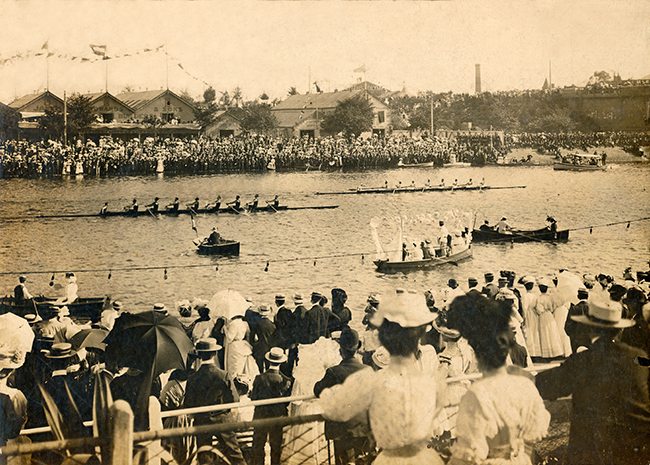
Mercantile takes out the Grand in front of Albert Park
Results
| Event | Won by | Other starters |
| Grand Challenge (senior eights) | Mercantile RC | Albert Park |
| Stewards Challenge (senior fours) | Nagambie RC | Banks, Civil Service, Hawthorn, Yarra Yarra |
| Yarra Challenge (sculls) | Mr Harold Brasch (Mercantile RC) | Row over |
| Ladies Challenge (school fours) | Scotch College | Row over |
| Elswick Challenge (junior fours) | Mercantile RC | Essendon, Footscray City |
| Junior eights | Footscray City RC | Albert Park |
| Maiden eights | MUBC | Albert Park, Banks, Civil Service, Corio Bay, Essendon, Footscray City, Mercantile, Nagambie, Richmond, South Melbourne, Yarra Yarra |
| Maiden fours | Old Wesley Collegians | Albert Park, Banks, Civil Service, Essendon, Footscray City, Hawthorn, Mercantile, Richmond, South Melbourne, Wendouree, Yarra Yarra |
24 silver cups were purchased by the Association in October 1907 to winners of the Challenge Cup races.
The Committee resolved that the Executive Committee should support the Victorian eight to attend the Interstate Championships on an ongoing basis.
1908
The course was changed for this and subsequent regattas. It was raced from the Punt Road footbridge to Engineers Corner, a measured mile. Other regatta Committees adopted the new course and it became known as the "Henley Mile". It is the same finishing point as used today.
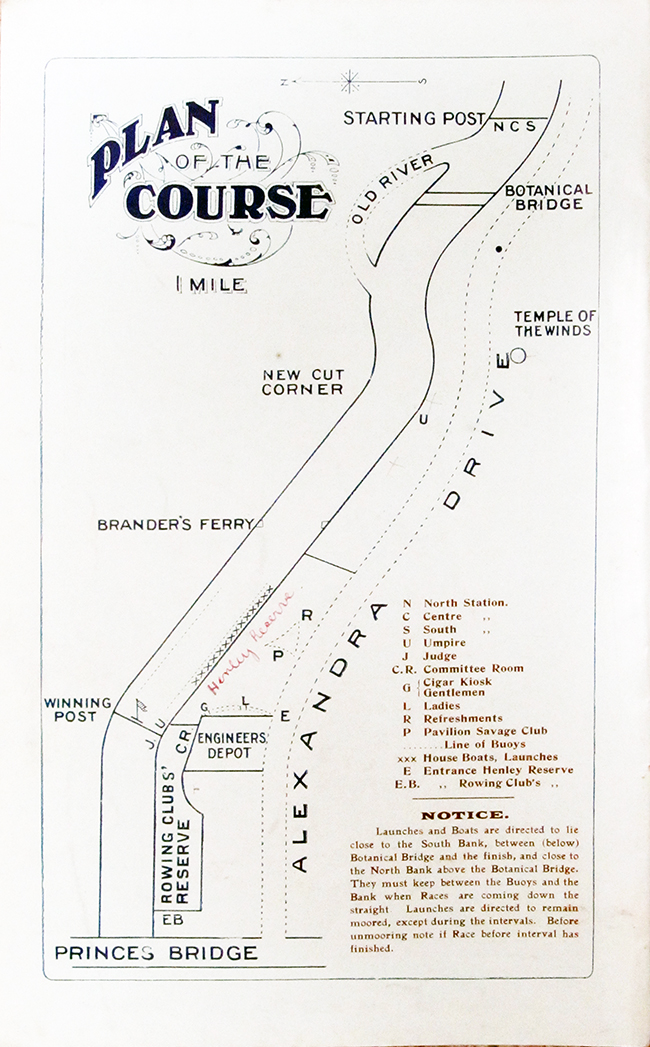
The regatta was another great success with record crowds. The Argus correspondent concluding that Henley-on-Yarra may now claim to be the greatest amateur rowing carnival of Australia despite being conducted so early in the season.10
The same correspondent spent many words describing how the drab Yarra River was transformed and the normal sombre clothing of spectators was replaced by brightly coloured fresh summer clothes. During the two breaks in the rowing program, brightly coloured boats and several motor launches meandered down the river for the entertainment of spectators.

The chaos of boats during a break
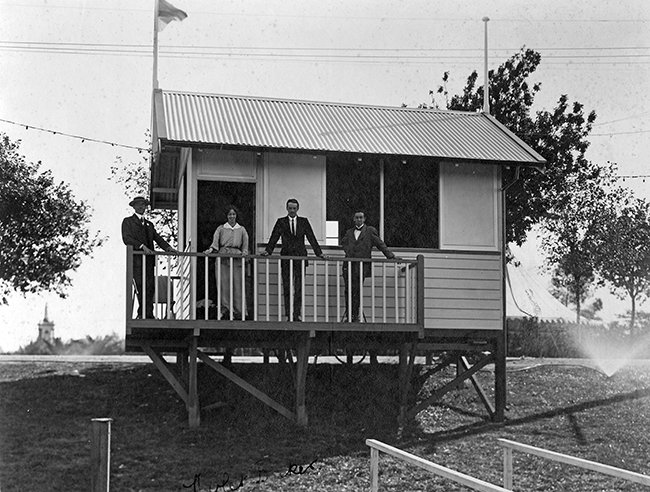 The temporary regatta office on the south bank - thought to be 1908
The temporary regatta office on the south bank - thought to be 1908
The regatta was becoming more Henley Royal Regatta than the original.
Again the river traffic control was only partially effective. In the racing, encroachment by spectators boats caused issues and for races to be restarted. Given that no agency had responsibility for policing the course, no one could act to prevent launches leaving their mooring during racing. The Association made representations to the Premier to create a body to control the river upstream from where the Harbour Trust responsibility ends. At that time, there was no body with control of the waterway beyond the banks.
The Argus correspondent also concluded: The transfer of the Henley reserve from the north to the south bank was a distinct improvement. Last year spectators had to promenade on a narrow, uneven slope along the north bank, but on Saturday the tastefully-designed reserve alongside Alexandra-parade provided ample accommodation and an excellent view of the races. The reserve, which was temporarily fenced for the occasion, was laid out by Mr. Catani, of the Public Works department. Its walks and lawns and general scheme at once suggest the hand of an artist. It also enabled crews to have a far fairer course with most of it straight.
The many house boats were thoroughly decorated. The evening program of music, lighting and fireworks were again popular with tens of thousands of spectators.
Mercantile had a great day of racing taking four races including the Grand. To encourage interstate school crews to attend, the Ladies Challenge Cup for schools was competed for in fours with Scotch College the victors. Harold Brasch again won the Yarra Challenge Cup, Footscray the Stewards and Mercantile the Grand, but only by 2 feet.
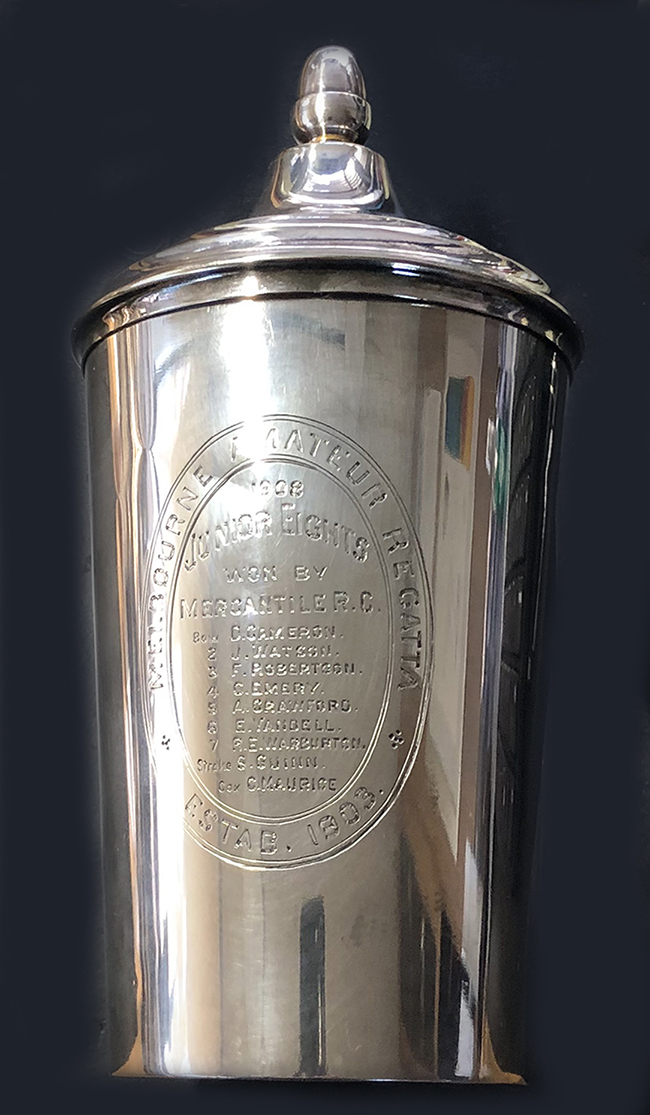
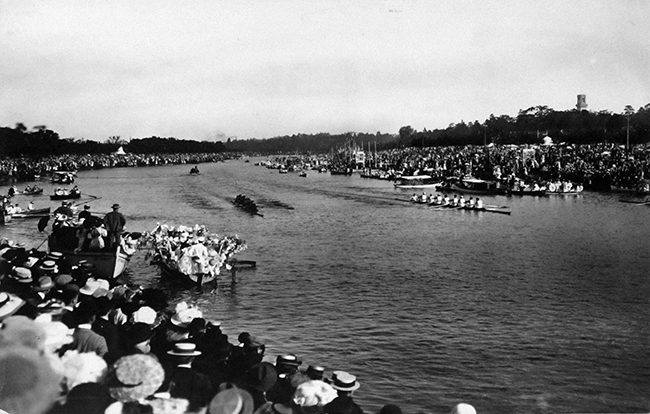
Mercantile narrowly winning the Grand from Albert Park.
The annual report presented in June 1909 showed a handsome profit and subscribers funds increasing to a balance £1,349. This was after a further contribution of £60 improvements to the lawns on the South bank, a contribution of £110 to rowing clubs, no doubt from the £88 profit on the rowing clubs reserve, and £25 to the Hospital Sunday Fund. Also, the Rowing Club Reserve Committee handed responsibility of that reserve to the Association, and finally, the Association paid a generous annual rental of £120 for 10 years for the south bank reserve in return for those funds being used by the Lands Department for improvements relevant to the regatta.
Results
| Event | Won by | Other starters |
| Grand Challenge (senior eights) | Mercantile RC | Albert Park |
| Stewards Challenge (senior fours) | Footscray RC | Albert Park, Civil Service, Mercantile |
| Yarra Challenge (sculls) | Mr Harold Brasch (Mercantile RC) | Mr Edward Kenny (Mercantile), Mr A Richards (South Melbourne) |
| Ladies Challenge (school fours) | Scotch College | Melbourne Grammar |
| Elswick Challenge (junior fours) | Mercantile RC | Row over |
| Junior Eights | Mercantile RC | Banks, Barwon, South Melbourne, MUBC, Wendouree, Yarra Yarra |
| Maiden Eights | Civil Service RC | Albert Park, Banks, Essendon, Hawthorn, Mercantile, Nagambie, Richmond, South Melbourne, MUBC, Yarra Yarra |
| Maiden Fours | Yarra Yarra RC | Albert Park, Banks, Civil Service, Footscray City, Mercantile, Old Wesley Collegians, Richmond, Seymour, MUBC |
1909
A record crowd of some 60,000 people witnessed the Henley Carnival this year helped by excellent spring weather. The number was even denser for the evening's entertainment. River traffic again caused issues with the event and caused yet more newspaper calls for a resolution. 11 However the Association's lobbying caused control of the river to be vested by legislation in the Ports and Harbours Department. They buoyed the last quarter mile of the course to mark out the forbidden area for spectator craft. The improvements were marked but still the junior eights had to be re-rowed due to interference by pleasure craft.
The 1909-10 annual report proudly noted that the assets of the Association now comprised: five challenge cups, cash turnstiles, ticket sales-boxes and ticket receptacles, result and progress-of-races boards, notice boards, Judge's box, specimen silver cup, cash bags, pistol, two wooden pontoons, flags, badges, pegs, and sundries, the cost of which represents £531 2s. 2d. After providing now £130 to rowing clubs, the £120pa rental to the Victorian government, subsidies of £36 for the visiting Tasmanian crews, and donation to the Hospital Sunday Fund of £50, the Association's net assets increased to £1,807. The Association also paid for repairs to the Princes Bridge boat staging which had fallen into disrepair.
His Excellency the Governor-General and the State Governor continued to attend regatta on their house boat. Their boat was fronted by the Di Gilio's spring band to the appreciation of spectators. The annual report recorded that: Other House Boats were occupied by Mr. George Fairbairn (President) and Mr. L. C. Mackinnon; the Lord Mayor and Lady Mayoress (Colonel and Mrs. Burston); Miss Helen Simson and Mrs. L. K. S. Mackinnon; the Alexandra Club; the Athenaeum Club; the Australian Club; the Bohemian Club; the Commercial Travellers' Club; the Mercantile Rowing Club; and the Wallaby Club. The Savage Club and Civil Service Rowing Club had Pavilions on the lawn.
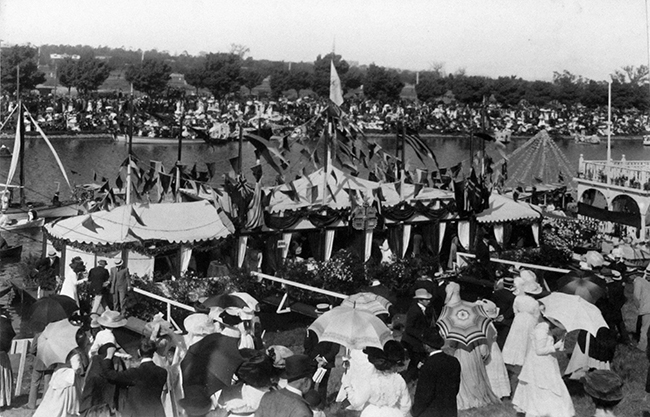 The house boat of the Lord Mayor and Lady Mayoress
The house boat of the Lord Mayor and Lady Mayoress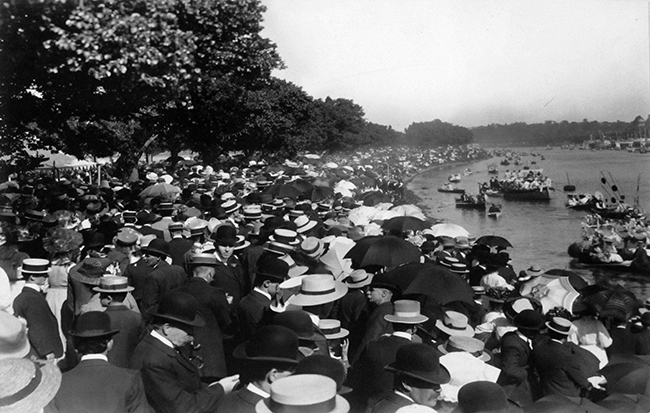 North bank
North bank
The Argus correspondent again was gushing in his praise of the regatta, its colour, the smiles of spectators and the activities. He concluded: This, the seventh Henley, will surely be known as the brilliant Henley in the future.
There was much debate generated by the rowing clubs about the best course with views varying from moving the finish line upstream 100 yards and others who wanted top revert back to Princes Bridge.
Racing - the honours were well spread this year with the first Interstate winner with Tamar Rowing Club taking out the Stewards. It would have pleased the Committee to both see interstate crews race, but be successful. Albert Park took the honours in the Grand and Percy Ivens once again won the Yarra Challenge Cup.
| Event | Won by | Other starters |
| Grand Challenge (senior eights) | Albert Park RC | Footscray City, Mercantile |
| Stewards Challenge (senior fours) | Tamar RC (Launceston) | Civil Service, Essendon, Franklin (TAS), Yarra Yarra |
| Yarra Challenge (sculls) | Mr P C Ivens (Mercantile RC) | Mr Edis Brown (Tamar), Mr W C Harvey (Mercantile), Mr Edward L Kenny (Mercantile), Mr A Richards (South Melbourne) |
| Ladies Challenge (school fours) | Melbourne Grammar | Scotch College |
| Elswick Challenge (junior fours) | Yarra Yarra RC | Albert Park, Civil Service, Franklin (TAS), Mercantile, MUBC |
| Junior Eights | Banks RC | Essendon, South Melbourne |
| Maiden Eights | MUBC | Banks, Civil Service, Essendon, Footscray City, Hawthorn, Mercantile, Melbourne Grammar, Old Wesley Collegians, Richmond, South Melbourne, MUBC (second crew) |
| Maiden Fours | South Melbourne RC | Albert Park, Banks, Essendon, Footscray City, Mercantile, Richmond, MUBC Yarra Yarra |
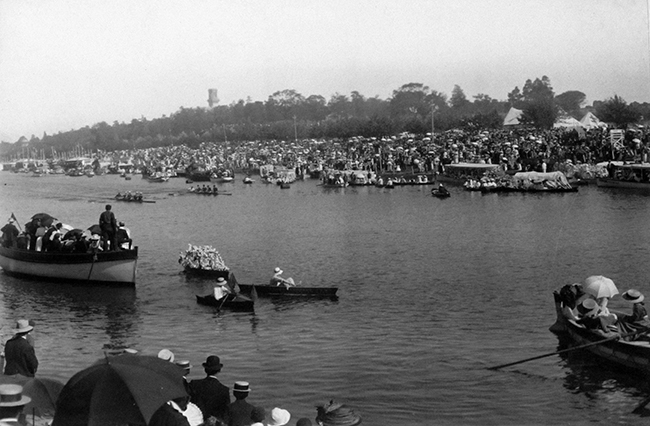
Approaching the finish
1910
The regatta continued to grow with 100,000 spectators cramming the banks of the Yarra River to be part of the pageant that is Henley.12 It had also become a national event with full coverage in all States of the Australia.

The regatta in 1910
The finances of the regatta demonstrated this importance with Association funds rising to £2,598 which was described as a sound position in the annual report. This result was after payment of £120 rental to the Public Works Department in addition to their costs of £115. Further, the Association was undertaking river improvements jointly with the Public Works Department, the total cost of which amounted to £450, £225 of which was expensed in the current year. The improvements included a pedestrian path only the southern bank and the Henley staging. Finally, a £130 donation was made to Victorian rowing clubs, £35 to visiting Tasmanian crews and £100 to the Hospital Sunday Fund.
Of note at this regatta were the placement of booms over the last quarter of a mile of the course which was a great improvement on the buoys used since the 1909 regatta, and the far great use of St Johns Ambulance teams at various parts of the course. They dealt with many minor maladies, mainly fainting.
The Argus correspondent waxed lyrical about the regatta and then went a step further regarding the evening entertainment. An extract of this work follows: The sinking of the sun over Henley was like the lowering of the lights in the theatre before newer and more gorgeous scenes are unveiled. New sights, new lights, new colours, new sounds, flickered and hovered about the river. A new world was created by a magic touch the city disappeared re-treated into the Shadowland which bordered the new world. Not a single sound came from the blackness which engulfed the city, not even the distant peal of a tram bell. No lights appealed to shine but the lights of Henley. All other lights were extinguished by the dashing glow of colour which flooded the river. Etc..
However he was correct in describing the carnival with the rowing as a mere pleasant distraction: Some visitors begin Henley early, some late. It is a day of informality. The chief business of the day, which is not the racing, begins when you like and ends when you are tired. That is the charm of this regatta. It may be taken easily and unconventionally. The main business seems to be to watch the constant procession of gaily decorated boats cruising slowly up the river under the south bank, and dropping down again beneath the crowded movement of the north. Between the two long booms making the course the crews, fours and eights, with their coxswains yelling at them through megaphones, glide up and shoot down, and are noticed as pleasing incidents.
The regatta had captured the imagination of Melbourne with those who paid and frequented the south bank, and the non-paying public on the north bank. Everyone was pleased. However, one spoilt sport wrote to The Argus asking how the regatta could make the south bank enclosures off from the public. Regardless, the regatta again brough great praise and joy to Melbourne. The cost of the fire works display had increased this year to £75.
It is also timely to note that the regatta was not a major undertaking but continued to be organised by volunteers. Whilst the regatta employed workers and many contractors, the key roles were volunteers. It was therefore entirely reasonable that the hard working Hon. Secretary John Lang should be voted a well deserved honorarium of £75.
Of interest was a request from the Premier of Victoria that a race be conducted at the regatta between two crews from the training ship "John Murray". Of perhaps more interest was the fact that the Executive Committee refused the request on the basis that the regatta was already drawn. The Committee had the confidence and strength to refuse such requests.
Racing - Tasmanian crews again raced at the regatta, and for the first time, St Peter's College from Adelaide raced.
The regatta was marred by an incident in the last 100 yards of the Grand Challenge Cup when both finalists were racing level. A large boat trespassed onto the course and the University crew crashed full speed into it. Their boat was broken and the race was re-rowed the next day before a good crowd. The University crew won by a length after a close race. The regatta committee agreed to recompense University for the damage. Banks Rowing Club won three of the races being the most successful club.
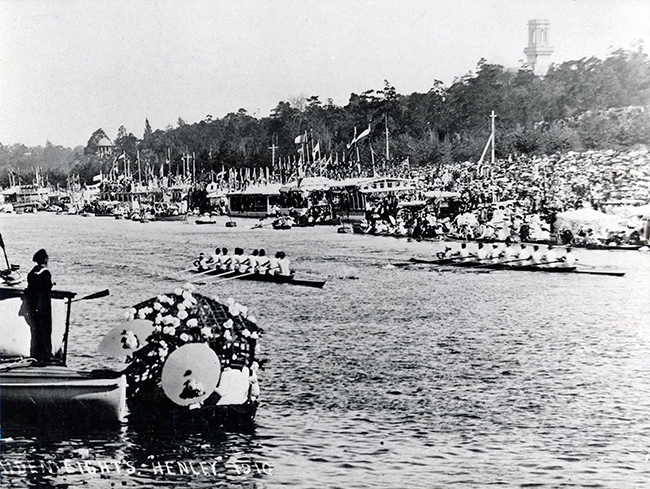
1910 Maiden Eight won by half a length by Banks
| Event | Won by | Other starters |
| Grand Challenge(senior eights) | MUBC | Albert Park, Footscray City, Mercantile, South Melbourne, Yarra Yarra |
| Stewards Challenge (senior fours) | North Esk RC (Launceston) | Banks, Civil Service, Essendon, Tamar (Launceston) |
| Yarra Challenge (sculls) | No starters | |
| Ladies Challenge Cup (school fours) | Scotch College | Melbourne Grammar, St Peter's College (Adelaide) |
| Elswick Challenge (junior fours) | Banks RC | South Melbourne, Yarra Yarra |
| Junior Eights | Banks RC | Essendon, MUBC |
| Maiden eights | Banks RC | Albert Park, Barwon, Civil Service (2 crews0, Essendon, Footscray City, Hawthorn, Mercantile, Richmond City, South Melbourne, MUBC, Yarra Yarra |
| Maiden Fours | Sandy Bay RC (Hobart) | Albert Park, Banks, Civil Service, Derwent (Hobart), Footscray City, Old Wesley Collegians, MUBC, Yarra Yarra |
1911
It was another boom year for the regatta. Now well over 100,000 people attended the regatta with 50 special trains being put on to ferry spectators to the Yarra River.13 That was not the only means of transport as the The Age reported: The avenue was the scene of extraordinary activity. The viceregal carriages, claret and white, were conspicuous among countless motor cars, pony carts, broughams and the good old fashioned landaus, which brought many visitors on Saturday. From early in the afternoon till long after dark the procession of vehicles never ceased, and they alone constituted a record for this most memorable Henley. 14 It was reported that in the estimation of Victorians, only the Melbourne Cup stands equivalent to, or greater than, this event.
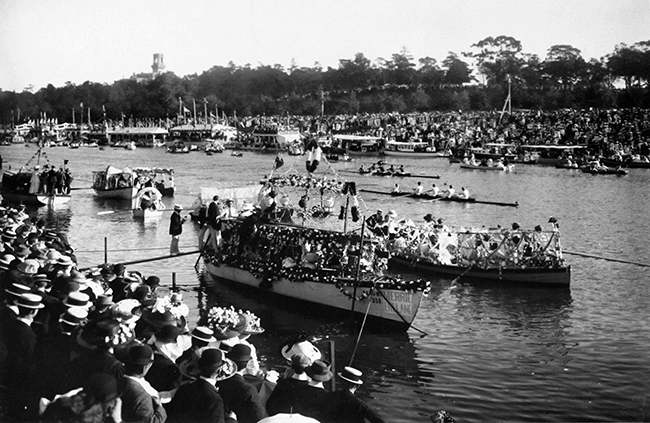
The view from the north bank with South Melbourne defeating Sandy Bay in the maiden four final
The evening entertainment was boosted again. Even the under stated annual report recorded that the fire works display "was on a far greater scale, and combined with the other illuminations, made the scene a brilliant one".
The finances were again adjudged to be sound with member funds at year end increasing to £3,346 after some significant donations and contributions to river improvements. The contribution to the rowing community increased considerably. Of special note was the £550 donation to the Australian Olympic rowing team making the regatta the largest donor despite the crew having only two Victorians in it, £163 to Victorian rowing clubs which now included country clubs who competed, and £62 to the costs of the Victorian State team. As usual there was a £100 donation to the Hospital Sunday Fund and the balance of the cost of the river improvement costs begun the previous season.
The annual report of the Association reported that the Olympic team donation was made with a sense of pleasure in being enabled to assist a movement of this sort, which object the founders of the Regatta had in mind. The support of Australian representation in an international event was the object referred to in this quote and the fact that the Olympic rowing team would also race at Henley Royal Regatta made such a donation easy to justify.
The annual report also highlighted the the river improvements being made including the new Henley staging which was completed in time for the regatta, the two paths along the river, one along the waters edge and the other at the top of bank and the grading and grass planting of the slopes. They also noted that the government refused to contribute to the cost of these works so the Association paid for the full cost of them.
Regatta posters were printed but sadly none have survived.
And to add to the nature of the event, the Executive Committee decided that the Association should buy three punts to be used as house boats for the regatta. The house boats at the regatta were hosted by the Governor-General, the Victorian Governor, Mr & Mrs George Fairbairn, the Australian Club, Bohemian Club, Alexandra Club, Wallaby Club, Commercial Travellers' Club, Miss Simson and Mrs L K S Mackinnon, with the Savage Club and Mercantile Rowing Club having Pavilions on the lawns. The Athenaeum Club found it impossible to get a suitable barge and was regretfully missed by the Committee.
In summary the regatta was the making significant contributions towards the sport of rowing and the City of Melbourne.
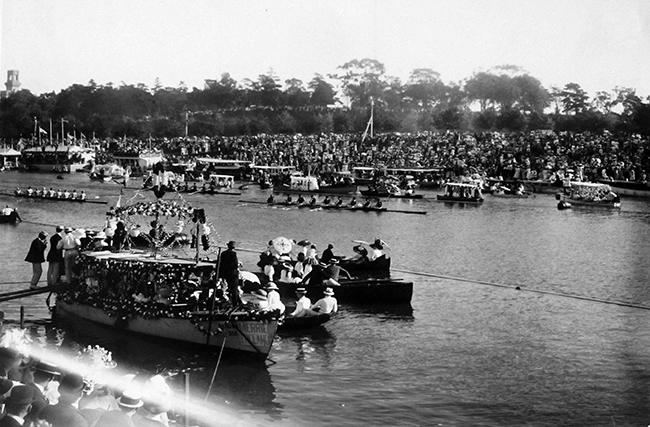
Junior eight final with Essendon leading
Rowing - all races were started by pistol for the first time. Again there was a crash in the Stewards before the start causing significant boat damage. The race was postponed until Monday to get a result. The final in the grand was won by only two feet after a similarly close race in the heat.
Results
| Event | Winner | Other starters |
| Grand Challenge (senior eights) | Albert Park RC | Banks, Mercantile, MUBC, Wendouree |
| Stewards Challenge (senior fours) | Albert Park RC | Banks, Cobram, Essendon, Mersey, North Esk, South Melbourne, Yarra Yarra |
| Yarra Challenge (sculls) | Mr Horace E Stevens (Essendon RC) | Mr E T J Kerby (Civil Service), Messrs Mervyn Keen and A Cox (Tamar) |
| Ladies Challenge (school fours) | St Peter's College (Adelaide) | Melbourne Grammar, Scotch College, Xavier College |
| Elswick Challenge (junior fours) | Footscray City RC | Banks, Civil Service, MUBC |
| Junior Eights | Essendon RC | Albert Park, Banks, Civil Service, MUBC (two crews), Yarra Yarra |
| Maiden Eights | Civil Service No 1 crew | Albert Park, Banks, Civil Service No 2, Corio Bay, Essendon, Fooscray City, Mercantile, Nagambie, Richmond City, South Melbourne, MUBC, Warrnambool, Yarra Yarra |
| Maiden Fours | South Melbourne | Albert Park, Banks, Barwon, Civil Service Corio Bay, Essendon, Footscray City, Hawthorn, Mercantile, Richmond City, Sandy Bay, Yarra Yarra |
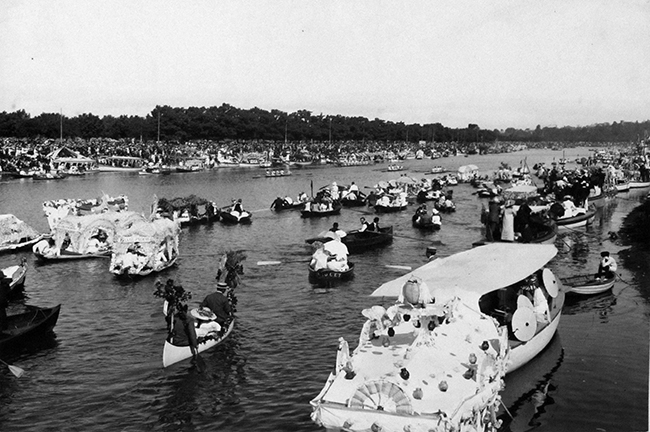
The regatta crowds in 1911 extending from Punt Road to Princes Bridge
1912
The weather for the regatta was again perfectly suited for the occasion although was threatening early which impacted crowds. The newspapers of the day still reported 100,000 spectators travelling by train with the Argus praising the Committee on the consistency of the regatta rather than growth of it. It was becoming increasingly evident that more means of transportation of spectators from the suburbs to the regatta was required with those travelling by tram facing a long walk home due to overloaded trams. The Argus reporting that the services needed to be doubled for the return home at night.
The Governor's house boat again hosted both the Governor-General as well as his "suites" and distinguished guests. The purchase by the Committee of their our houseboat for subscribers was welcomed and well patronised. Other house boats were hosted by the President and his wife, Australian Club, Commercial Travelers' Club, Wallaby Club, and the Bohemian Club The Alexandra Club were unable too secure sufficient pontoon space for its members and so was regrettably missing. The Savage Club occupied a pavilion on the lawn.

The house boat of the President Mr George Fairbairn and his wife Mrs Fairbairn. The Australian Club house boat is in the background.
The annual report noted the completion of the river improvements and this year invested heavily in regatta equipment, more than doubling the value of these assets.
The annual report also spent much space describing the 1912 Olympic rowing team successes. The Committee was a major sponsor of the team. Team manager Charles S Cunningham from Mercantile RC made excellent progress in attempting to arrange the visit of an English crew to the Australian Henley Regatta. Sadly it did not result in success on this occasion but has set in place the groundwork for a future visit. The minutes of the general meeting of 18th October 1912 also recorded the advice of James Macfarlane to New South Wales after the 1908 attempt to send a crew.
After payment of donations of £50 to each of the Hospital Sunday and the Mount Lyell Relief Funds, £166 to Victorian rowing clubs and a further £100 to interstate and country club expenses in competing at the regatta, the balance of river improvements costs of £227 and the investment of some £850 in regatta equipment, the Association managed to maintain member funds of £3,362.
In addition to St Johns stations throughout the crowds, the Royal Life-saving Society provided competent life-savers to manage on-water safety.14 This addition was thought to have commenced in 1909 given a receipt from the Society in that year. The payment to Victoria Police indicated that some 33 Constables were employed for the regatta during the day an additional two for the night. The Department of Ports and Harbors also charged the Association for 24 Constables on top of the wages for watermen on their boats.
The music for the regatta was provided by the Mercantile Marine Band, the Vice-Regal Band of some 20 players, the Prahran City Band, seven artists provided by the Australian Vaudeville Artists' Association and an organist. The cost of the fire works display again jumped to £150 demonstrating the expansion of the display and importance to the Henley carnival.
The Founders Challenge Cup was presented for the first time this year to commemorate the founding of the regatta in 1903 by the by George Fairbairn, Capt. Rivett and Arthur Blackwood. It is a handsome silver cup of Australian design and workmanship.
Racing - Crews from three States other than Victoria competed at this regatta. The Yarra Challenge attracted scullers from NSW and Tasmania. Albert Park won the grand for the second time in succession.
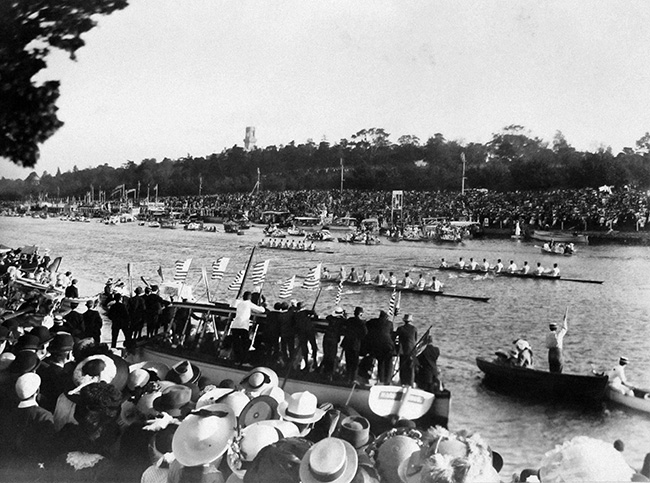
Hawthorn RC win over Civil Service in the final of the maiden eights, Barwon is in third place.
| Event | Winner | Other starters |
| Grand Challenge (senior eights) | Albert Park RC | Civil Service, Mercantile, MUBC |
| Stewards Challenge (senior fours) | Essendon RC | Albert Park, Richmond, Wendouree |
| Yarra Challenge (sculls) | Mr L T J Kerby (Civil Service) | Mr H Green (enterprise, NSW), Mr L Blakeley (Leichhardt, NSW), Mr E Christie (Sandhurst), Mr Percy C Ivens (Mercantile), Mr M Keen (Tamar, TAS) |
| Ladies Challenge (School fours) | Melbourne Grammar | Scotch College, St Peter's College (Adelaide) |
| Elswick Challenge (junior fours) | Nagambie RC | Civil Service, Corio Bay, Enterprise (NSW), Mercantile, Richmond, Tamar (TAS) |
| Founders Challenge (junior eights) | Civil Service RC | Albert Park, Banks, Footscray City, North Esk (TAS), South Melbourne, MUBC |
| Maiden Eights | Hawthorn RC | Albert Park, Ballarat, Banks, Barwon, Civil Service (2 crews), Essendon, Footscray City, Mercantile, Richmond, South Melbourne, Yarra Yarra (2 crews), MUBC (2 crews), Wendouree |
| Maiden Fours | Essendon RC | Albert Park, Bairnsdale, Banks, Civil Service, Essendon (second crew), Hawthorn, Mercantile, Nagambie, Richmond, Sandhurst, Shepparton, South Melbourne, MUBC, Wendouree (2 crews) |
1913
The number of spectators grew this year with transport issues again being highlighted. It was a record crowd well over 100,000, with record attendance fees paid for the south bank.15
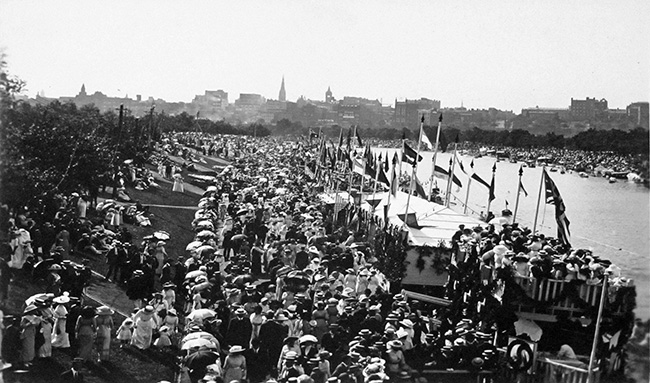
The view towards the city
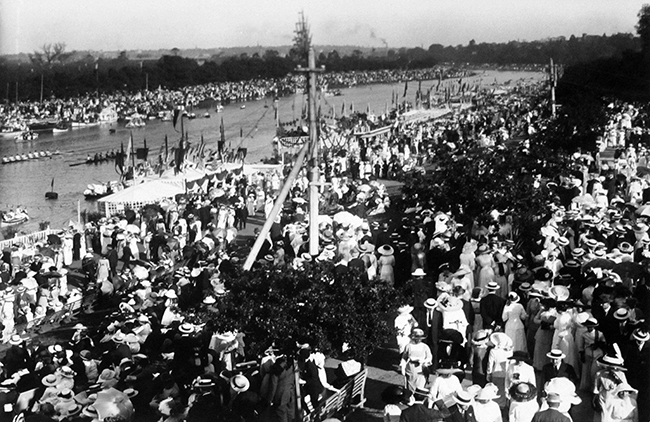
The view towards New Cut Corner showing part of the south bank enclosure
The house boats were occupied this year included the Governor's boat at which the Governor-General again attended, the Lord Mayor's boat, the President's boat, the Australian Club, the Subscribers, Bohemian Club, Overseas Club, and the Wallaby Club. The Savage Club again had a pavilion on the lawns.
The evening entertainment, specifically the fire works and illumination displays attracted a growing crowd.
The Associations' annual report published in 1914 for the annual meeting, the finances were adjudged by the Committee to be sound and the profit rate appropriate. After payment of donations, club subsidies and river improvements, the Association was left with a most satisfactory £4366 in member funds.
In the annual report, the Association reflected on their financial contribution to Melbourne and the sport of rowing over the 10 years of its existence as follows:
| River improvements | £1342 |
| Rowing | £1923 |
| Services and rent to government | £811 |
| Charity | £475 |
| £ 4,551 |
This was of course in addition to the pride and enjoyment provided to the city.
The Committee also took steps to invite a crew from the UK to compete and again were unsuccessful.
Racing - the weather was perfect for racing having little wind or tide issues. The Grand Challenge was a great tussle between the winners Civil Service and Albert Park with the final margin of only 6 inches. A record 19 crews raced in the maiden fours with Hawthorn taking the honours. A large entry from neighbouring States was gratifying for all concerned.
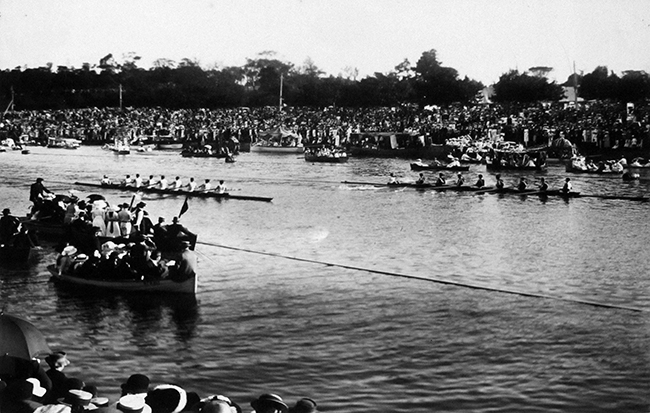
Nagambie leads in the final of the Founders Challenge
| Event | Won by | Other starters |
| Grand Challenge (senior eights | Civil Service RC | Albert Park, Ballarat, Footscray City, MUBC, Mercantile |
| Stewards Challenge (senior fours) | Torrens RC (Adelaide) | Banks, Essendon, Civil Service, Murray Bridge (SA), South Melbourne, Yarra Yarra |
| Yarra Challenge (sculls) | Mr Alma Cox (Balmain RC NSW) | Mr T Barrell (South Melbourne), Mt E T J Kerby (Civil Service), Mr E D Thomas (Murray Bridge SA) |
| Ladies Challenge (school fours) | Melbourne Grammar | Ballarat Agricultural High School, Ballarat Grammar, St Josephs College (NSW) |
| Elswick Challenge (junior fours) | Hawthorn RC | Bairnsdale, Ballarat City, Civil Service, Derwent (TAS), Leichhardt (NSW), Sale Shepparton, |
| Founders Challenge (junior eights) | Nagambie RC | Albert Park, Civil Service, MUBC, Richmond |
| Maiden eights | Richmond RC | Albert Park, Banks, Barwon, Civil Service (two crews), Essendon, Footscray City, Mercantile, Sandhurst, South Melbourne (two crews), MUBC (two crews) and Yarra Yarra |
| Maiden fours | Hawthorn RC | Albert Park, Ballarat, Banks, Bairnsdale, Civil Service, Corio Bay, Essendon (two crews), Footscray City, Mercantile (Two crews), North Esk (TAS), Richmond, Sandy Bay (TAS), Shepparton, South Melbourne, MUBC, Warrnambool |
There was an attempt at 15th July 1912 general meeting that trophy orders rather than silver cups be provided to winning crews. Fortunately this idea was not accepted. At the same meeting, it was noted that the number of subscribers had fallen and a special privilege should be provided to them such as a house boat. The Committee agreed to provide a house-boat in 1914.
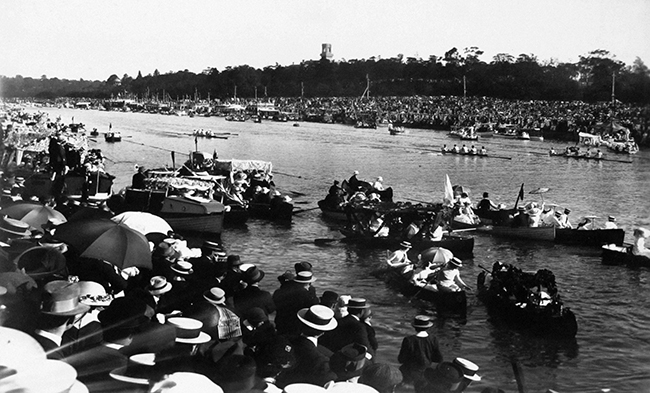
Final of the Maiden fours with Hawthorn leading Civil Service with Banks in third place
1914
This was to be the last regatta before the Great War. The weather was appalling with a strong northerly wind accompanied by clouds of dust and a temperature 100 degrees fahrenheit. The Argus reported: If Henley was a success on Saturday and it undoubtedly was, it succeeded in spite of many things. It succeeded despite the heat, despite the dust, despite the north wind, and it did it on ice. It was an iced carnival. 16 The spectator attendance was considerably lower as a result of the record high October temperature.
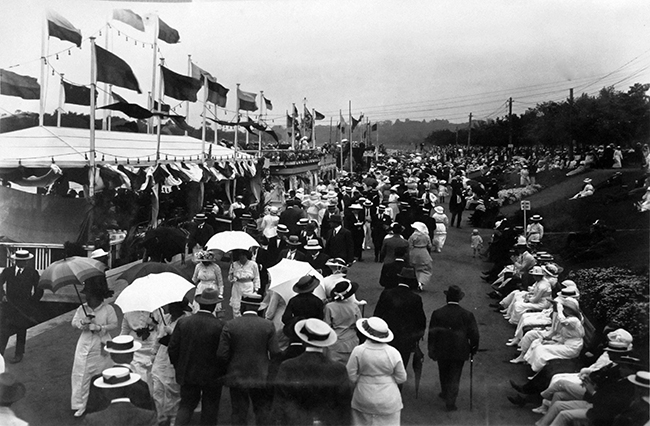
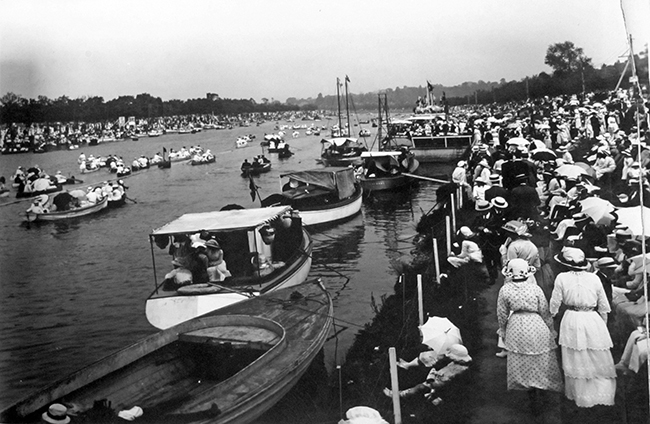
1914 regatta scenes showing a far lower number of spectators and boats
More so was the anxiety of the European war which was declared 4th August prior to the regatta. The Subscribers met to determine whether the regatta should continue. Many rowers had already enlisted to serve in the war. It was unanimously decided to run the regatta as it gave a considerable amount of employment. The Subscribers also determined that the profits should be equally divided equally between the Hospital Sunday Fund War Patriotic Funds or such other funds as the Executive Committee determined. Despite there being no profit arising from this regatta, £306 of donations were paid and no dividend was paid to the Victorian clubs.
Given the far lower attendance and the poor weather, members fund reduced.
The Silver Sculls. The annual report recorded the following. It will be noted that the name of the "Yarra Challenge Cup" has had the words "and Silver Sculls" added to it. Your Association counts itself extremely fortunate in having this trophy, which was presented to us by Mr. C. H. Tuckett, of Melbourne, in September last, for perpetual competition in our regatta Sculling event. The Silver Sculls are the original trophy of the Melbourne Regatta for the Amateur Sculling Race founded in 1860. They and our Elswick Challenge Cup (the Grand Challenge Cup of the Melbourne Regatta, won by the Elswick Rowing Club in 1862) are the oldest rowing trophies in Victoria. The Silver Sculls were competed for from the year 1860 to the year 1880, and on the latter occasion, having been won by the late Mr. W. H. Tuckett for the third successive time, they became his absolute property. On behalf of the Association we desire to record our sincere thanks to Mr. C. H. Tuckett (brother of the Champion Amateur Sculler of the seventies and eighties) for presenting this valuable and interesting trophy to us.
Racing - The entries were good under the circumstances and included a good interstate contingent.
| Event | Won by | Other starters |
| Grand Challenge (senior eights) | MUBC | Civil Service, Footscray City, Leichhardt (NSW), Wendouree |
| Stewards Challenge (senior fours) | Torrens RC (Adelaide) | Albert Park, Ballarat, Enterprise (NSW), Essendon, Mercantile (SA), Nagambie |
| Yarra Challenge and Silver Sculls (sculls) | Mr B G T Kelly, Yarra Yarra RC | Mr E T J Kerby (Civil Service), Mr Harry Green (Enterprise RC NSW), Mr E Roberts (Essendon) |
| Ladies Challenge (school fours) | Melbourne Grammar School | Ballarat Agricultural High School, St Patrick's College, Ballarat |
| Elswick Challenge (junior fours) | Essendon RC | Bairnsdale, Corio Bay, South Melbourne |
| Founders Challenge (junior eights) | Mercantile RC | Civil Service, MUBC, Richmond |
| Maiden eights | Hawthorn RC | Albert Park, Banks (2 crews), Civil Service, Essendon, MUBC, Mercantile, Richmond, South Melbourne, Wendouree, Yarra Yarra |
| Maiden fours | Civil Service RC | Albert Park, Banks, Essendon, Footscray City, Mercantile, Richmond, South Melbourne, Tamar (Launcetson), Yarra Yarra |
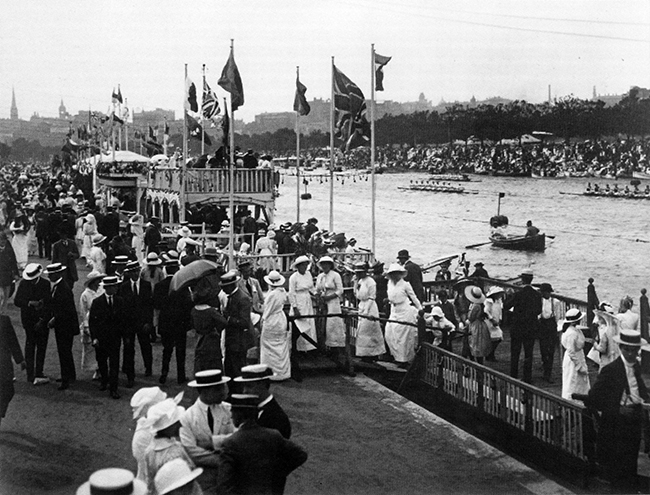
Second heat of the Grand Challenge with MUBC leading Leichhardt followed by Wendouree
1915
The regatta was not conducted due to WWI. Accordingly no Executive Committee was elected and the Hon. Secretary John Lang absented himself due to military service.
The 1915 annual meeting resolved that £500 be donated to Lady Stanley's Australian Sick and Wounded Fund. The Association also had ongoing fixed costs and other commitments which led to a considerable loss. Member fund were reduced to £3074.
At the 5th November 1915 meeting of the Committee, a sub-committee of Sir Edward Carlile, Messrs. Henty, Strachan, Flack, Macfarlane, Keep, Warland and Wharton was authorised to run the association.
1916
John Lang tendered his resignation as Hon. Secretary and this was accepted with great regret. The meeting recorded its appreciation and thanks for the very valuable services rendered by you in the interests of Australian Henley since the year 1904 when you first assumed office. He was elected as a member of the general committee. No activities were conducted by the Association. But with ongoing financial commitments, another, albeit smaller, loss and reduction in member funds resulted. The Association negotiated a lower rental of £60 for the south bank enclosure from the Lands Department.
The Melbourne City Council sought a yearly contribution from the Association of £10 towards the maintenance of boat staging which was agreed. This was to be the start of a bigger and longer story on maintaining and rebuilding the staging.
The Red Cross were lent the chairs owned by the Association and the sub-committee maintaining the Association during the war given permission to loan out other property of the Association at their discretion.
1917
No activities were conducted by the Association. But with ongoing financial commitments, another small loss was recorded together with a resulting reduction in member funds. The Association negotiated a lower rental of £30 for the south bank enclosure from the Lands Department. A donation of £5.5.0 was made to the Trickett Memorial Fund.
Sir Edward Carlile resigned from the Committee in June 1917. The Committee accepted his resignation with regret and thanked him for his valuable services to the Association.
1918
No activities were conducted by the Association. The ongoing financial commitments stabilised so that no loss resulted. In correspondence to a subscriber, there was clearly a request to hold a regatta in 1918 given that the end of the war was nigh. However the General Committee decided not to proceed. The Hon. Treasurer Edwin Flack responded: I might explain that this course was adopted for the reason that as the majority of oarsmen of the eligible rowing men have enlisted for active service, it is almost impossible to get together suitable crews, and furthermore the Victorian Rowing Association has declined to sanction the holding championship Regattas.
At the September 1918 meeting of the Committee, a sub-committee of Messrs. Strachan, Flack, Henty, Macfarlane, Crosthwaite, Kenny and Jones were empowered to manage the Association. Messrs Strachan and Macfarlane renegotiated a 10 year lease of the Reserve. The Committee also began planning for a 1919 regatta.
£2.500 of expired term deposits would be reinvested in War Loan and the balance placed on term deposit. The War Loan investment would be in the form of Inscribed Stock.
Sources
Annual reports, Committee minutes and regatta programs have been used extensively without reference. The annual reports and regatta programs can be found in Appendix B and Appendix C.
- HENLEY-ON-YARRA. SUCCESSFUL INAUGURATION. (1904, March 21). The Argus (Melbourne, Vic. : 1848 - 1957), p. 6. Retrieved January 6, 2025, from http://nla.gov.au/nla.news-article10604682
- HENLEY-ON-YARRA. (1904, June 21). The Argus (Melbourne, Vic. : 1848 - 1957), p. 8. Retrieved January 6, 2025, from http://nla.gov.au/nla.news-article10325672
- HENLEY ON THE YARRA. (1904, October 24). The Argus (Melbourne, Vic. : 1848 - 1957), p. 5. Retrieved January 7, 2025, from http://nla.gov.au/nla.news-article10346878
- HENLEY-ON-YARRA. (1905, October 30). The Argus (Melbourne, Vic. : 1848 - 1957), p. 5. Retrieved January 7, 2025, from http://nla.gov.au/nla.news-article10028363
- SPORTING INTELLIGENCE. (1905, September 29). The Argus (Melbourne, Vic. : 1848 - 1957), p. 9. Retrieved January 8, 2025, from http://nla.gov.au/nla.news-article9881826
- HENLEY-ON-YARRA. (1906, October 24). The Argus (Melbourne, Vic. : 1848 - 1957), p. 7. Retrieved January 8, 2025, from http://nla.gov.au/nla.news-article9656936
- PUBLIC SCHOOLS' RACE. (1906, October 29). The Argus (Melbourne, Vic. : 1848 - 1957), p. 7. Retrieved January 8, 2025, from http://nla.gov.au/nla.news-article9655756
- HENLEY-ON-YARRA (1907, June 28). The Argus (Melbourne, Vic. : 1848 - 1957), p. 4. Retrieved January 8, 2025, from http://nla.gov.au/nla.news-article10644898
- HENLEY-ON-THE-YARRA. FIFTH ANNUAL REGATTA. (1907, October 28). The Argus (Melbourne, Vic. : 1848 - 1957), p. 7. Retrieved January 9, 2025, from http://nla.gov.au/nla.news-article10157804
- HENLEY-ON-YARRA. (1908, October 26). The Argus (Melbourne, Vic. : 1848 - 1957), p. 6. Retrieved January 9, 2025, from http://nla.gov.au/nla.news-article10187846
- HENLEY-ON-YARRA. BRILLIANT SCENES. (1909, October 25). The Argus (Melbourne, Vic. : 1848 - 1957), p. 7. Retrieved January 9, 2025, from http://nla.gov.au/nla.news-article10742972
- "HENLEY REGATTA. A SUNLIT PAGEANT." The Argus (Melbourne, Vic. : 1848 - 1957) 24 October 1910: 7. Web. 13 Jan 2025 <http://nla.gov.au/nla.news-article10471258>.
- "HENLEY=ON=YARRA." The Argus (Melbourne, Vic. : 1848 - 1957) 30 October 1911: 8. Web. 14 Jan 2025 <http://nla.gov.au/nla.news-article11628093>.
- HENLEY-ON-YARRA. (1912, October 18). The Argus (Melbourne, Vic. : 1848 - 1957), p. 12. Retrieved January 15, 2025, from http://nla.gov.au/nla.news-article10511869 THE SOCIAL SIDE. (1911, October 30). The Age (Melbourne, Vic. : 1854 - 1954), p. 10. Retrieved January 14, 2025, from http://nla.gov.au/nla.news-article197390073
- HENLEY ON THE YARRA (1913, October 27). The Argus (Melbourne, Vic. : 1848 - 1957), p. 7. Retrieved January 15, 2025, from http://nla.gov.au/nla.news-article7226535
- "HENLEY=ON=YARRA." The Argus (Melbourne, Vic. : 1848 - 1957) 26 October 1914: 7. Web. 15 Jan 2025 <http://nla.gov.au/nla.news-article10813625>.


